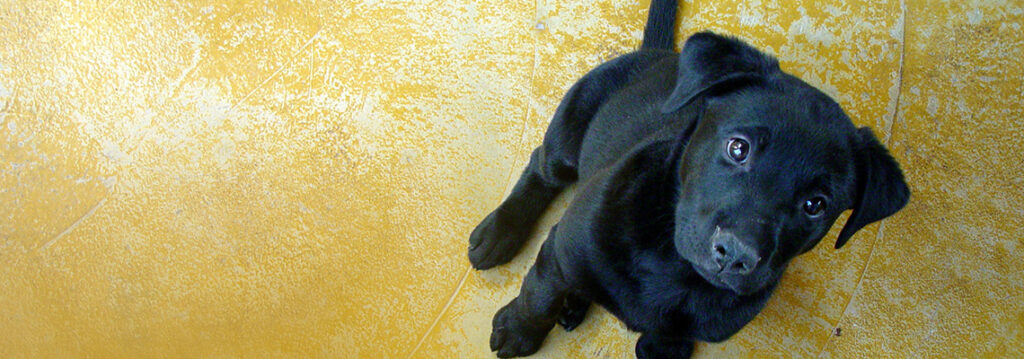

Rescue dogs are always an emotive subject. As well as the desperately sad stories we hear, we’re also lucky enough to meet numerous ACANA and ORIJEN customers who regularly foster or have adopted dogs, some of them rescued from puppy farms, who soon become happy family pets.
New legislation, Lucy’s Law, was introduced in England in an effort to improve welfare standards and to crack down on high volume, low welfare breeders. The new rules ban pet shops and third-party dealers from selling puppies and kittens under six months old. Despite there being fewer than 100 licenced third-party sellers in the UK, between 40,000 and 80,000 puppies were sold through third parties in 2017 (source: Blue Cross).
Re-homing organisations, such as dog charities and sanctuaries, are thankfully not affected by Lucy’s Law. There are huge numbers of puppies and dogs looking for their forever home and, as the interest in dog adoption grows, we look at some of the ways in which you can approach feeding a rescue puppy.
Take it slowly
Many rescue puppies will have been fed on low-quality diets. Often the first time they will have had regular and complete meals will be in the rescue centre, where they try to offer their dogs the best food. However, because they rely on donations, the quality can vary greatly.
Puppies need a protein-rich diet from a diversity of fresh whole meats with smaller amounts of fruits and vegetables to support their rapid growth and development. When puppies are welcomed into their new homes, you will want to offer them the best food. A change of diet can be stressful which can lead to upset digestion, so it is a good idea to allow your puppy a few days to settle into the home before gradually introducing a new diet.
Plan the transition
The rescue centre or foster parent will inform you what your puppy has been fed on and how regularly. Puppies under five months old will typically need feeding three to four times a day at scheduled intervals. It is important to stick to a routine, so to help your puppy to understand this, you should leave the bowl of food down for five minutes, and then remove it until the next scheduled feeding.
Introduce new food gradually, start by mixing 25% of new food with 75% of the old. Slowly change the proportions over the next five to seven days by gradually increasing the amount of new food and decreasing the old. At the end of this transitioning process, you should be feeding 100% new food. Always read the feeding guide as this will differ between brands and products.
Treats
We all want to spoil our pets, particularly when they have been through hardship, but it is important not to offer too many treats which can lead to upset tummies and obesity. Treats should not make up more than 10% of your puppy’s daily food allowance. We would suggest using a portion of your puppy’s daily food allowance for training.
For your puppy, why not try…
ACANA and ORIJEN’s puppy foods are varied in fresh whole meats with smaller amounts of fruits and vegetables.
ACANA Puppy Small Breed is rich in free-run chicken, wild-caught flounder and cage-free eggs eggs designed to promote your small breed puppy’s development with a diet rich in proteins and fats. For puppies weighing up to 9kgs at maturity.
Ingredients: 70% free range chicken, wild fish and cage-free eggs, 30% vegetables, fruits and botanicals. Absolutely no grain, rice, tapioca or potato.
ACANA Puppy and Junior is brimming with free-run chicken, cage-free eggs and wild-caught flounder to nourish peak health. For puppies weighing 9 – 25kgs at maturity.
Ingredients: 70% free range chicken, wild fish and cage-free eggs, 30% vegetables, fruits and botanicals. Absolutely no grain, rice, tapioca or potato.
ACANA Puppy Large Breed is loaded with free-run chicken, wild-caught flounder and cage-free eggs protein to develop muscles, yet limited in carbohydrates and calories to manage body weight and reduce stress on developing bones and joints. For puppies weighing over 25kgs at maturity.
Ingredients: 70% free range chicken, wild fish and cage-free eggs, 30% vegetables, fruits and botanicals. Absolutely no grain, rice, tapioca or potato.
ORIJEN Puppy is brimming with natural protein and fat from fresh meats, including free-run chicken and turkey, whole wild-caught fish and cage-free eggs to help fully support a puppy’s rapid growth and development.
Ingredients: 85% meat, fish and egg ingredients and 15% vegetables, fruits and botanicals. Absolutely no grain, rice, tapioca or potato.
ORIJEN Puppy Large is loaded with protein from fresh free-run chicken and turkey, whole wild-caught fish and cage-free eggs, designed to support large breed muscle mass, yet limited in calories to promote a healthy body weight.
Ingredients: 85% meat, fish and egg ingredients and 15% vegetables, fruits and botanicals. Absolutely no grain, rice, tapioca or potato.
If you’re thinking of re-homing an adult dog why not try one of our most popular foods, ACANA Adult Dog?
Our Top Feeding Tips
- For puppies that have only been fed wet food, you may need to add water to the kibble, or try using a freeze-dried food as topper, to make it more enticing.
- Keep your puppy active and reduce boredom by introducing food-related toys and games.
- Greedy puppies may gulp their food down, which can impact on their digestion. Try using a tray to spread out the food, or feed little and often.
- If your puppy is nervous, it may be necessary to give them gentle encouragement to their food bowl and allow more time in your feeding routine.
- Consider the type of bowl you are using. If your puppy won’t eat out of a metal bowl, try switching to a plastic one.
- Puppies should naturally be enthusiastic about their food, so if your puppy loses its appetite, consult your vet.
